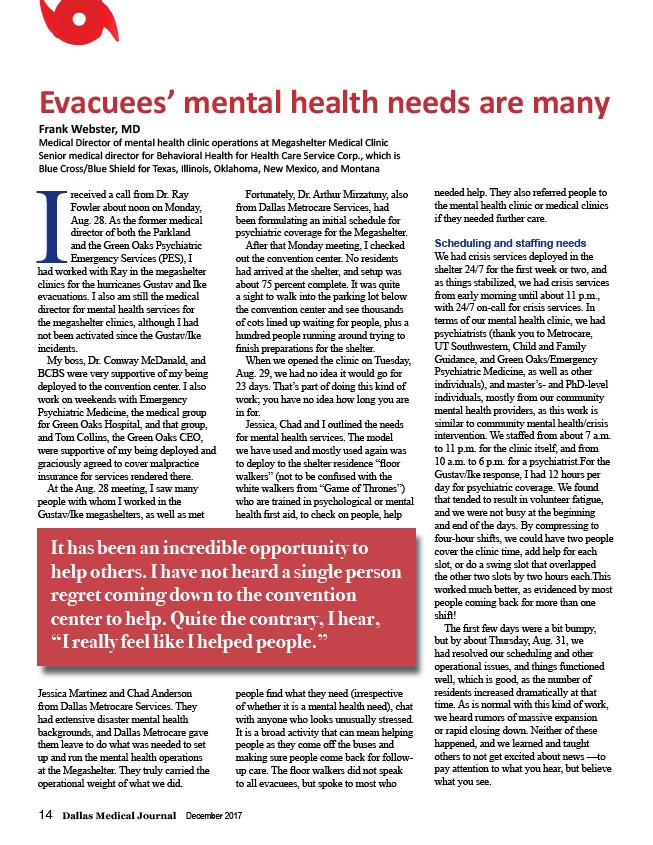
Evacuees’ mental health needs are many
Frank Webster, MD
Medical Director of mental health clinic operati ons at Megashelter Medical Clinic
Senior medical director for Behavioral Health for Health Care Service Corp., which is
Blue Cross/Blue Shield for Texas, Illinois, Oklahoma, New Mexico, and Montana
received a call from Dr. Ray
Fowler about noon on Monday,
Aug. 28. As the former medical
director of both the Parkland
and the Green Oaks Psychiatric
Emergency Services (PES), I
had worked with Ray in the megashelter
clinics for the hurricanes Gustav and Ike
evacuations. I also am still the medical
director for mental health services for
the megashelter clinics, although I had
not been activated since the Gustav/Ike
incidents.
My boss, Dr. Conway McDanald, and
BCBS were very supportive of my being
deployed to the convention center. I also
work on weekends with Emergency
Psychiatric Medicine, the medical group
for Green Oaks Hospital, and that group,
and Tom Collins, the Green Oaks CEO,
were supportive of my being deployed and
graciously agreed to cover malpractice
insurance for services rendered there.
At the Aug. 28 meeting, I saw many
people with whom I worked in the
Gustav/Ike megashelters, as well as met
Jessica Martinez and Chad Anderson
from Dallas Metrocare Services. They
had extensive disaster mental health
backgrounds, and Dallas Metrocare gave
them leave to do what was needed to set
up and run the mental health operations
at the Megashelter. They truly carried the
operational weight of what we did.
Fortunately, Dr. Arthur Mirzatuny, also
from Dallas Metrocare Services, had
been formulating an initial schedule for
psychiatric coverage for the Megashelter.
After that Monday meeting, I checked
out the convention center. No residents
had arrived at the shelter, and setup was
about 75 percent complete. It was quite
a sight to walk into the parking lot below
the convention center and see thousands
of cots lined up waiting for people, plus a
hundred people running around trying to
fi nish preparations for the shelter.
When we opened the clinic on Tuesday,
Aug. 29, we had no idea it would go for
23 days. That’s part of doing this kind of
work; you have no idea how long you are
in for.
Jessica, Chad and I outlined the needs
for mental health services. The model
we have used and mostly used again was
to deploy to the shelter residence “fl oor
walkers” (not to be confused with the
white walkers from “Game of Thrones”)
who are trained in psychological or mental
health fi rst aid, to check on people, help
people fi nd what they need (irrespective
of whether it is a mental health need), chat
with anyone who looks unusually stressed.
It is a broad activity that can mean helping
people as they come off the buses and
making sure people come back for followup
care. The fl oor walkers did not speak
to all evacuees, but spoke to most who
14 Dallas Medical Journal December 2017
needed help. They also referred people to
the mental health clinic or medical clinics
if they needed further care.
Scheduling and staffi ng needs
We had crisis services deployed in the
shelter 24/7 for the fi rst week or two, and
as things stabilized, we had crisis services
from early morning until about 11 p.m.,
with 24/7 on-call for crisis services. In
terms of our mental health clinic, we had
psychiatrists (thank you to Metrocare,
UT Southwestern, Child and Family
Guidance, and Green Oaks/Emergency
Psychiatric Medicine, as well as other
individuals), and master’s- and PhD-level
individuals, mostly from our community
mental health providers, as this work is
similar to community mental health/crisis
intervention. We staffed from about 7 a.m.
to 11 p.m. for the clinic itself, and from
10 a.m. to 6 p.m. for a psychiatrist.For the
Gustav/Ike response, I had 12 hours per
day for psychiatric coverage. We found
that tended to result in volunteer fatigue,
and we were not busy at the beginning
and end of the days. By compressing to
four-hour shifts, we could have two people
cover the clinic time, add help for each
slot, or do a swing slot that overlapped
the other two slots by two hours each.This
worked much better, as evidenced by most
people coming back for more than one
shift!
The fi rst few days were a bit bumpy,
but by about Thursday, Aug. 31, we
had resolved our scheduling and other
operational issues, and things functioned
well, which is good, as the number of
residents increased dramatically at that
time. As is normal with this kind of work,
we heard rumors of massive expansion
or rapid closing down. Neither of these
happened, and we learned and taught
others to not get excited about news —to
pay attention to what you hear, but believe
what you see.
I
It has been an incredible opportunity to
help others. I have not heard a single person
regret coming down to the convention
center to help. Quite the contrary, I hear,
“I really feel like I helped people.”